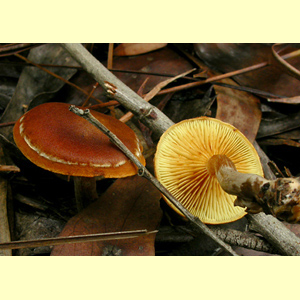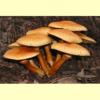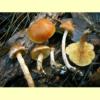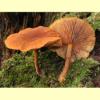






_AJ_15_sml.jpg)
Bougher, N.L. & Syme, K. (1998), Fungi of Southern Australia. University of Western Australia Press, Nedlands. [Description, Illustration and Microcharacters of G. allantopus (as G. austrosapineus)]
Fuhrer, B. (2005), A Field Guide to Australian Fungi. Bloomings Books, Hawthorn. [Description and Illustration of G. allantopus, G. dilepis, G. junonius and G. penetrans (this species not confirmed from Australia)]
Fuhrer, B. & Robinson, R. (1992), Rainforest Fungi of Tasmania and South-east Australia. CSIRO Press, East Melbourne. [Illustration of G. allantopus (as Gymnopilus sp.)]
Grey, P. & Grey, E. (2005), Fungi Down Under. Fungimap, South Yarra. [Description, Illustration and Map for G. junonius]
Grgurinovic, C.A. (1997a), Larger Fungi of South Australia. The Botanic Gardens of Adelaide and State Herbarium and The Flora and Fauna of South Australia Handbooks Committee, Adelaide. [Key to eleven South Australian species, and Description and Microcharacters of the species, along with B&W Illustration of G. eucalyptorum]
Hood, I.A. (2003), An Introduction to Fungi on Wood in Queensland. University of New England, School of Environmental Sciences and Natural Resources Management, Armidale. [Description and B&W Illustration of G. cf. ferruginosus, G. junonius and Pyrrhoglossum ferruginosum (as 'ferruginatum')]
Horak, E. (1988a), On some extraordinary species of Galerina Earle from New Zealand, Australia and Indonesia, with annotations to related South American taxa, Sydowia 40: 65–80. [Description, B&W Illustration and Microcharacters of G. perplexus (as Galerina eucalyptorum)]
McCann, I.R. (2003), Australian Fungi Illustrated. Macdown Productions, Vermont. [Illustration of G. allantopus and G. pampeanus, as well as several unidentified species]
Rees, B.J. & Lepp, H. (2000), A new species of Gymnopilus from Norfolk Island, Australas. Mycol. 19: 36–40. [Description, Illustration and Microcharacters of G. norfolkensis]
Rees, B.J. & Strid, A. (2001), Relationships between Australian and northern hemisphere Gymnopilus species. 1: new species and common misconceptions regarding earlier names, Australas. Mycol. 20: 29–48. [Description, Illustration and Microcharacters of G. allantopus, G. austropicreus, G. crociphyllus, G. ferruginosus and G. junonius]
Rees, B.J. & Taeker, F. (1999), Profiles of fungi. 107. Pyrrhoglossum pyrrhum, Mycologist 13: 133–134 [Description and Illustration of G. pyrrhum (as Pyrrhoglossum)]
Rees, B.J. & Wood, A.E. (1999), Profiles of fungi. 105. Galerina eucalyptorum, Mycologist 13: 132 [Description and Illustration of G. perplexus (as Galerina eucalyptorum)]
Rees, B.J. & Ye, J.L. (1999), Pyrrhoglossum and the small-spored species of Gymnopilus (Cortinariaceae) in eastern Australia, Austral. Syst. Bot. 12: 255–270 [Description, B&W Illustration and Microcharacters of G. marginatus, G. parvisporus, G. patriae and G. pyrrhus (as Pyrrhoglossum)]
Rees, B.J., Marchant, A. & Zuccarello, G.C. (2004), A tale of two species - possible origins of red to purple-coloured Gymnopilus species in Europe, Australas. Mycol. 22: 57–72. [Description, Illustration and Microcharacters of G. dilepis and G. purpuratus, and Illustration of G. norfolkensis]
Rees, B.J., Orlovich, D.A. & Marks, P.B.D. (1999), Treading the fine line between small-statured Gymnopilus and excentrically stipitate Galerina species in Australia, Mycol. Res. 103: 427–442. [Description, B&W Illustration and Microcharacters of G. corticophilus, G. eucalyptorum, G. moabus, G. perplexus (as Galerina eucalyptorum), G. tasmanicus, G. tomentosulus and G. tyallus]
Young, A.M. (2005b), A Field Guide to the Fungi of Australia. University of New South Wales Press, Sydney. [Description and Illustration of G. junonius]
